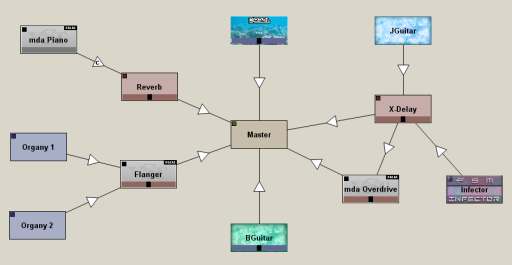For connections process vizualization a chain diagram certainly most convenient method.
There are some specific moments which complicate user actions.
Use of metaphors
In an example which you showed at GUI creation perfectly metaphors are used. A rear panel of the device with interfaces of possible connections and wires which are familiar to us in an everyday life is visually shown. If you once were engaged in connection of audio devices to you will define not difficult interaction with computer model as it copies mental model from real life. The second example is based on the general models possessing similar properties, the truth unlike model with metaphors shows process slightly worse. And that is why: There's an plugged devices named JGuitar or BGuitar, but it is difficult to me to define personally enough, what exactly is connected to my device. BGuitar it's abbreviation of bass guitar or it means that is a Bob's guitar, or it is any any name which my sound producer decided to give to this device? In this regard there are problems which I will describe in the following paragraph, but it already looks much more simply.

Connections compatibility
In most cases connections are divided into Input & Output, but what both functions at the same time can carry out meet also. Use of metaphors helps me with definition of sequence of connection. For example everyone know that headphones should be connected to an audio Output therefore there is no desire to connect them to a microphone Input. Though this connection also will work, but it won't be correct.
Here's an example of rich metaphor model from Line6 PodStudio

Here is not so difficult to define what device is connected, but there is other problem unlike examples which you gave. Even knowing rules of connection of these devices I can't define in what sequence they are connected. From left to right or in the opposite direction? In your example with Propellerheads GUI I can unequivocally tell that the direction of a signal extends from Output to Input, in an example with Jeskola Buzz though I also don't know where an Input and an Output, but the signal direction from a guitar to mixer is specified by an arrow.
Connection possibility
For example for audio devices there are at least three types of connection: analog, digital and Midi. Even if connections plugs coincide, you hardly will reach desirable result having connected Analog Output with Digital Input. Therefore it is necessary that the user unequivocally could determine on what by a method of the device can be connected or limit possibility of connection of incompatible connection types. In this plan the example of with Propellerheads is much better than an example with Jeskola Buzz because each Output contains information about connection type. (L/Mono for exmpl.)
Here's one more picture which will help to understand a problem.

It's not a part of the interface, it's simply a scheme showing one more advantage of the Propellerheads GUI. Here it is not so simple to define that is an Input, and that an Output, red arrows solve this problem in a chain not up to the end.
Number of devices you can connect is perfectly visible. Information on quantity of available Inputs as contains and in the Propellerheads GUI. There's only one possible connection for CV In, for exmpl. It is quite probable that in the Jeskola Buzz GUI it is possible to connect to any device infinitely many any devices. At least - visually with it interferes nothing.
Similar principles are used in SVaRTracker and Apple Midi Setup. Where you can see quantity and type of connections for each device. It is more convenient in use though it's not so beautiful as Propellerhead's GUI.


Actually not and it is difficult to solve this problem even by means of children's game.


Now it is possible to tell with ease that Jessica's Guitar and X-Delay use different types of connection, but besides, you can connect a Guitar with Mixer directly.
It is possible to use color or a form for connections marking, but in any case models with a metaphor which are familiar from life are simplest for understanding. Actually it also does Propellerhead's GUI.

RVMF
Rich visual modeless feedbackis one more aspect of the matter.
In my opinion in the best way it is realized in Reactable

or in Tangiblex Liveset

RVMF helps not only to define what devices are connected, but also the direction of a connection and even its type.
Whether in addition it is possible to define the device works and to estimate some parameters of its work. Volume level for example.
















